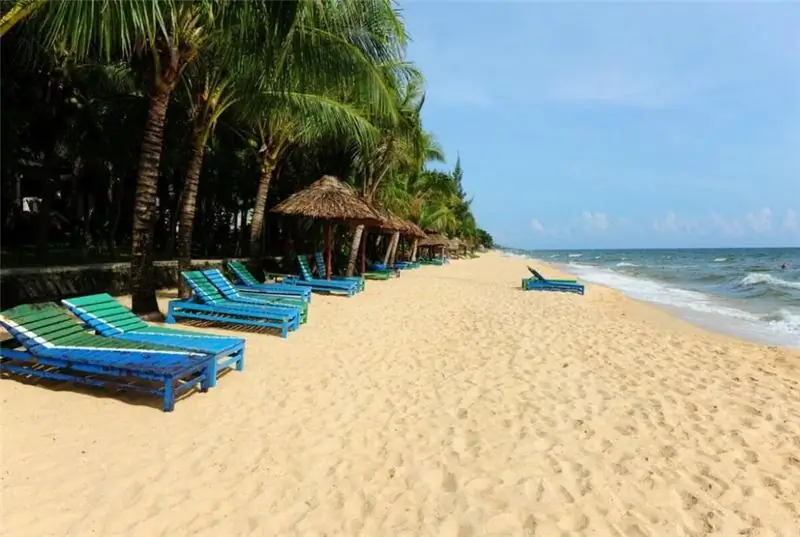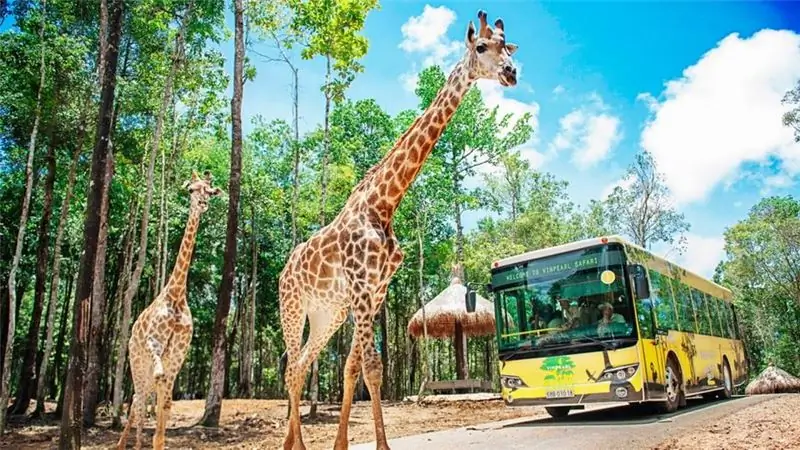
Phu Quoc Island is the largest island and the most interesting tourist center in Vietnam. The nature is rich and interesting here: almost 70% of its territory is occupied by a national park. On the island, in addition to the longest snow-white beaches, there are plantations of black pepper and pearls, as well as many entertainment centers.
Top 10 attractions in Fukuoka
Winperl Safari Phu Quoc

A huge safari park in the northwest of the island near the town of Bai Dai occupies more than 380 hectares, and it is home to more than three thousand large animals of various species. The main part of the territory is an open safari park, where animals are kept free outside the enclosures, you can ride on it in a car or on a special bus.
The different parts are separated not by walls and cages, but by water ditches. There is a large area with elephants to feed, a huge park with large birds: storks, peacocks and flamingos, there are big cats: lions and tigers. In addition, there is also a traditional zoo area where you can take pictures with animals.
Various shows are organized in the park, including ethnographic ones. For example, here you can see traditional Zulu dances, there are master classes on making Vietnamese toys, several restaurants and other entertainment.
Winperl Phu Quoc amusement park
Another entertainment center located near the popular Ong Lang Beach is considered one of the largest in Vietnam. In fact, this is a whole huge city, created in order to entertain and amaze tourists.
First of all, there is a huge water park here. It has a large family area with a shallow splash pool, wave pool, slow river and children's slides, and there are many adult extreme slides and attractions: Black Hole, Kamikaze, Tornado and others. In addition to water attractions, there are also the usual ones: for example, a 55-meter Ferris wheel, a 5D cinema, in which the chairs move in the direction of the action, and many special effects are involved - from wind and changing temperatures to smells.
The second part of the complex is a huge oceanarium, which consists of 46 separate aquariums. Its central part is a 100-meter underwater tunnel. The aquarium is divided into three colorful thematic zones: the life of the seas and oceans, the life of fresh tropical waters, the life of reptiles. Bright shows of mermaids and fish feeding, traditional for aquariums, are held here.
In addition to the entertainment area, a shopping area has been created in the park - a shopping street with Vietnamese souvenirs and a restaurant street with food for every taste and budget.
Pearl farm
Phu Quoc is called the "pearl island" for a reason: pearl cultivation is one of its main sources of income, along with tourism. Pearls and products from it are sold literally at every step, and around the island itself there are several pearl plantations.
The largest plantation and factory with a huge shop - Phu Quoc Pearl - is located on the east coast. Here you can see the details of the cultivation of cultured pearls. In fact, it is, of course, not artificial: pearls are formed inside mollusks, only people do not wait for some grain of sand to accidentally fall into their flaps, but artificially put small beads there, around which a layer of pearls gradually grows. And these mollusks live not in natural conditions, but in special nets. There are freshwater and marine molluscs of different types, they get pearls of different colors and sizes.
The shells are opened right in front of tourists, and you can see the process of extracting pearls with your own eyes.
Kao Dai Temple in Duong Dong
At the beginning of the twentieth century, a completely new religion appeared in Vietnam - Caoaism or Caodai. It now has several million adherents. Its founder was Ngo Van Thieu, to whom the deity Caodai appeared during a seance in 1926 and gave a revelation. The revelation consisted mainly in the fact that all world religions are partly true, but when a deity speaks to people through prophets, then the teaching can be distorted. There it happened to Moses, Buddha, Christ and all the others. Therefore, now God has found a new way - to address people directly through spiritualistic seances. Specially dedicated mediums are engaged in spiritualism, and the symbol of religion is a huge globe with an all-seeing eye. Among the Europeans known to us, for example, Shakespeare, Jeanne d'Arc and Leo Tolstoy are considered spiritual mentors and revered saints of this religion.
One way or another, this temple is worth a visit - it is very colorful, unusual and interestingly decorated both outside and inside, and the divine service is also magnificent in Vietnamese. In Europe, this is definitely not to be seen.
Pepper plantations
The second (and actually the first) specialization of the island is the cultivation of black pepper. It was brought here by the French in the 18th century and it turned out that the conditions of the island are excellent for this plant. There are different types of peppers and different processing methods, so Vietnamese peppers are different from Cambodian and Indian peppers.
Now it is Vietnam that is the world leader in the production of black pepper. Almost the entire island is covered with pepper plantations; pepper is more profitable to grow here than rice. Many plantations are open to tourists: they will willingly show the whole process of growing peppers, collecting and processing them. And they will be ready to sell any sort of pepper: white, red, and green, but in fact, 90% of production here is the most traditional black pepper. Only very aromatic and high quality, irreplaceable in any dish.
The pepper picking season lasts from February to July, but the rest of the time there is always something to see.
Fish Sauce Farm
The third brand of Fukuoka is a traditional fish sauce, without which no dish is complete. Fermented or fermented seafood sauces, which have a rather specific taste and smell, are one of the characteristics of Asian cuisine, and in each country such sauce is prepared differently.
Fukuoka also has its own version. It is prepared from small fish (here they do not even distinguish between species, calling all the little things in bulk "fish-rice", although these are mainly anchovies, which are found in abundance near the coast). Small fish are mixed with salt and put into fermentation barrels. Previously, they used wooden or clay barrels, now, of course, plastic is used first of all. Further, the sauce ripens in the sun - the corresponding smell stands for several kilometers around the factory. The ripening process can take several years - the best sauce is considered to be three years old.
The most popular fish sauce factory, which is visited by excursions, is located near the village of Zuongduong. This is a large-scale production: you cannot see handicraft exotic here, but it is relatively clean and civilized. However, be careful when buying souvenirs - it is prohibited to export sauces from Vietnam.
Duong Dong Local History Museum
The Duong Dong Regional Museum is a fairly young, but very interesting and rich museum. It was founded at the very beginning of the XXI century by local historian Huin Phuok Hu, at first just as a private collection of various historical wonders and artifacts at a restaurant, but now it occupies as many as five floors.
The museum tells about the nature of the island: for example, there are samples of sand from different beaches, shells, corals, stuffed animals and skeletons of marine animals. There is an archaeological collection of objects dating back to the 1st century AD. A separate exhibition is dedicated to the Coconut Prison - a place where Vietnamese rebels were imprisoned during the Indo-Chinese war in the middle of the 20th century. On one of the floors, the remains of a medieval merchant ship raised from the seabed are exhibited. There is a lot of ethnography: traditional products, national clothes, and cult objects.
Cable car
The island has the world's longest "sea" cable car - from Long Beach to Hon Thom island, it is listed in the Guinness Book of Records. Its length is 8 kilometers, and it passes about 180 meters above the sea. The road is absolutely safe: there are large glass cabins, each of which is about the size of a bus, and can accommodate up to 30 people. The flight time is about 20 minutes.
On the island itself, where the road leads, there is a beautiful park in antique style, there is a restaurant, and most importantly - a well-groomed beach with clear water and corals located very close. The cable car runs intermittently, so it's best to check the timetable so you don't have to wait more than an hour.
Fukuoka National Park
The main place for ecological tourism on the island: there are jungles, mountains, and wild virgin beaches at Cape Ganh Dau, located in the protected zone. Only 56 species of animals live in the park, but there are many birds and plants.
The entrance to the reserve is free, full-fledged trekking routes along it are currently being laid. There are several equipped eco-trails near the entrance, but in general the park is covered only by a network of dirt roads - you can move along them, on foot or on a mountain bike or even a motorcycle. The highest mountain in the park is Mount Chua, on which observation platforms have already been equipped at an altitude of about 600 meters above sea level. There are several camping sites in the park.
Duong Dong Markets

There are two markets in the city: "Night" (and in fact - evening) and "Day". The first is tourist entertainment: a colorful Vietnamese market with somewhat overpriced prices, souvenirs and a huge variety of food that is prepared right here.
The day market is a real market where locals buy food. Prices are lower here, but smells are stronger, and cleanliness is a problem. But the real exotic - for example, dog meat - is bought here. In the mornings, an active fish trade is conducted here; it unfolds right on the shore at the berths. And it is worth looking here for the exotic - such an abundance of various fish and marine animals can be seen only in aquariums and fish markets: squid, shrimp, crabs, lobsters, mussels, snails - which is just not there.






